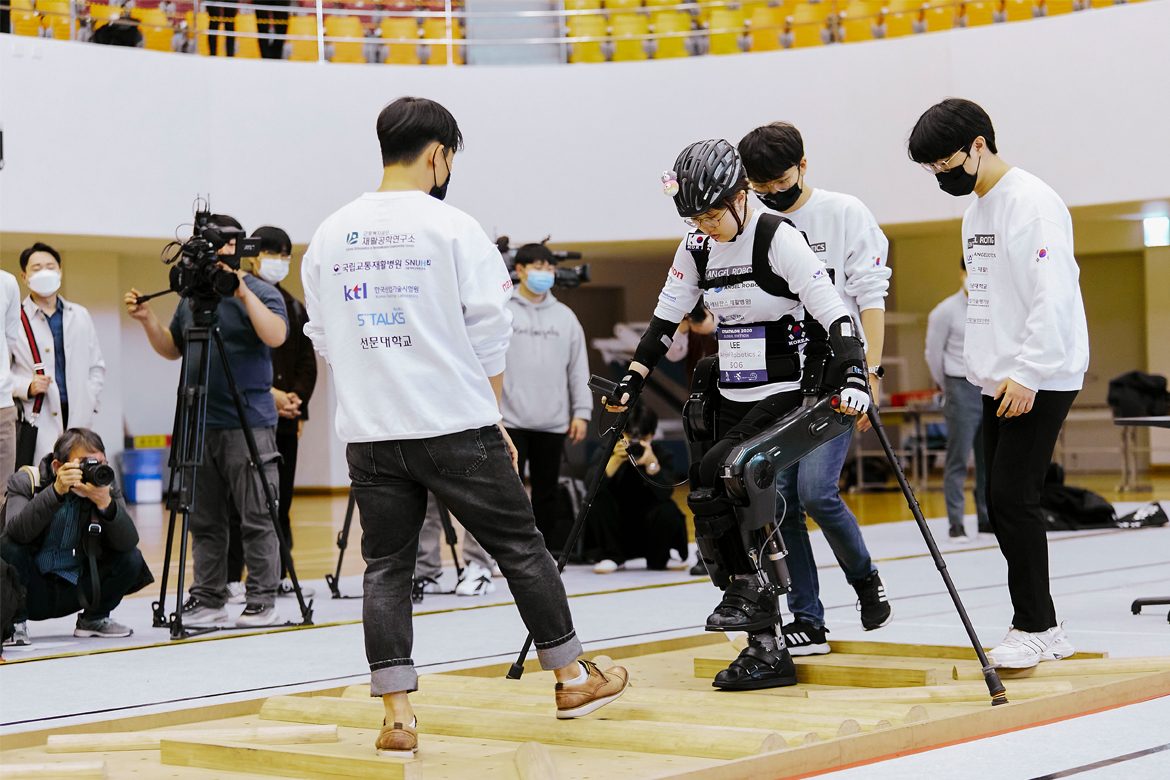- WalkON Suit is special in many technical aspects. First of all, it has super powerful actuator systems with built-in gear systems, and the ankle joints are controlled such that the wearer can walk faster and overcome obstacles with less human effort. However, the most important characteristic of the WalkON Suit is its balance.
- After Cybathlon 2016, we realised that the most common motion in daily life is not walking, but standing still. So, while many other researchers focused on how to make a person walk fast and well, my team had to study first how to make the person stand well.
- Powered exoskeletons are similar to electric vehicles. One big difference is the market size, and this is the point I am actually working on. Once we can find a good application of WalkON Suit for people without disability, the market size can be bigger, and probably many problems may get solved automatically.
On November 13th and 14th, Korea showed its status in robotics again to the world, in the Cybathlon 2020. Led by Prof. Kyoungchul Kong, from Korea Advanced Institute of Science and Technology, or KAIST, two teams won a Gold and Bronze medal respectively, in the wearable robots / powered exoskeleton field of Cybathlon 2020 competition.
With the aim to break down the barriers between the public, people with disabilities and technology developers, and to encourage social inclusion, Cybathlon kicked off its first race in 2016 under the umbrella of ETH Zurich in Switzerland, and had its second match this November. Cybathlon 2020 took place globally this time, as teams set up their infrastructures for the competition in their home bases and their races were filmed and broadcasted through a live platform.
Today Prof. Kyoungchul Kong is joining us to share his superb experience from the Cybathlon 2020 competition and more.
Hi, my name is Kyoungchul Kong, and people call me KC. I am a professor of the Department of Mechanical Engineering, KAIST in Korea. Also, I am the founder and CEO of Angel Robotics, which is a startup company that I made in 2017 to commercialise the powered exoskeleton that I have developed.
My research team participated in the powered exoskeleton race of Cybathlon 2016 and 2020. This shows the video of what we did for Cybathlon 2016 (refer to video below), and my team won the bronze medal that year. So, he was the pilot of the powered exoskeleton, a ‘WalkOn Suit’, and we got a bronze medal.
In 2020, the two pilots of my team won Gold and Bronze medals and we had two pilots, one female and one male pilot. Most of them had three trials respectively, and they got full scores for all the six missions in six trials. He got a gold medal, finishing all the missions in 3’47, and she won the bronze medal, finishing the 5’51.
So your teams, Angel Robotics 1 and 2, won both Gold and Bronze medals. What would that mean to you, especially after your participation in 2016?
When I developed this technology, I wanted to develop a wearable robot technology that is not only special for one person, but for everyone who needs this technology. Therefore, at the beginning of the preparation of Cybathlon 2020, I recruited seven pilot candidates, and of course, seven robots. Their body conditions were very different. Eventually, the two candidates with the most different physical conditions became the official pilots of Cybathlon.
Mr. Byeong-Uk Kim (left) was one of the pilots of team Angel Robotics and he has a really strong upper body with very muscular arms. Ms. Joo-Hyun Lee (right) is a female with much less muscle compared to Mr. Byeong-Uk Kim. They have different body conditions and both of them became the medalists of Cybathlon, so I am proud that this might prove that the WalkON Suit is both special and general.
How is this WalkON Suit robot distinctive from other wearable robots?
WalkON Suit is special in many technical aspects. First of all, it has super powerful actuator systems with built-in gear systems, and the ankle joints are controlled such that the wearer can walk faster and overcome obstacles with less human effort.
However, the most important characteristic of the WalkON Suit is its balance. You can see in the video (refer to video below) that the paraplegic person can stand still wearing the robot without pushing crutches for a long time.
After Cybathlon 2016, we realised that the most common motion in daily life is not walking, but standing still. So, while many other researchers focused on how to make a person walk fast and well, my team had to study first how to make the person stand well. Ironically, after we found a good balance of the robot, the walking speed also became fast. Now it is as fast as the walking speed of people without disability.
This is a cross competition between the powered exoskeleton and the powered wheelchair races. Many people have questioned the meaning of powered exoskeletons because if they use wheelchairs, they might be faster and more convenient, and if then what is the purpose of the powered exoskeleton?
But this video shows that Mr. Byeong-Uk Kim wearing the WalkON Suit was actually faster than the other wheelchairs. So now this prejudice that powered exoskeleton is too slow in practice may be broken by the WalkON Suit.
Do you have any commercialisation plan for the robots used in the race?
It is my dream. But there are still many technologies that need to be developed to be utilised in daily life. First of all, don and doff must be easy and convenient, such that a paraplegic person can wear the robot without other’s help.
Weight is another problem. Once they wear the robot, they don’t feel the weight of the robot. But to handle the robot (such as putting it in or taking it out from cars or moving it from one place to another), the weight must be light enough.
Recharging is another practical problem. Powered exoskeletons are similar to electric vehicles. One big difference is the market size, and this is the point I am actually working on. Once we can find a good application of WalkON Suit for people without disability, the market size can be bigger, and probably many problems may get solved automatically.
Are there any other robots that are already commercialised to the public?
Yes. My team already has commercialised a wearable robot called Angel Legs. This is a powered exoskeleton for rehabilitation of people with partial impairment in walking ability. For example, post-stroke patients and elderlies with weakened muscles are the target users of Angel Legs. Unlike the WalkON Suit, Angel Legs is force-controlled. That means, when you do not any assistance, this robot does not do anything, but when you need some assistance, it helps you with the appropriate force. Angel Legs has received all the necessary certifications in Korea, and patients can simply visit a hospital that has Angel Legs to practice walking with it by following the prescription of a rehabilitation doctor.
In addition, we have another robot called the Angel-Suit. This is a personal powered exoskeleton, intended for use in daily life. Unlike the WalkON Suit, this is for people with partial impairment, but also unlike the Angel Legs, it is for personal use in daily life. It is much lighter and many people are already using it in public.
Last but not least, please tell us about your personal, and your team’s research plan in the near future.
I really appreciate the fact that the wearable robots of my team are receiving great attention from the public. It is our turn to show something in practice. I think we are on the right path, but we should work harder to complete the commercialisation of the real powered exoskeleton so that all the people who need this technology can use it in daily life.
In terms of research, we are also making another technology for people without disabilities. This is a new robot to overcome the physical limit of humans. For example, the FLASH-suit is a powered exoskeleton that makes the running speed of a person faster. So who knows? The next 100m sprint record might come from wearable robots.
We are making all kinds of fun, interesting technologies. I’d like to continue generating for the world, surprising technologies.
Watch the full video here –






NO COMMENT